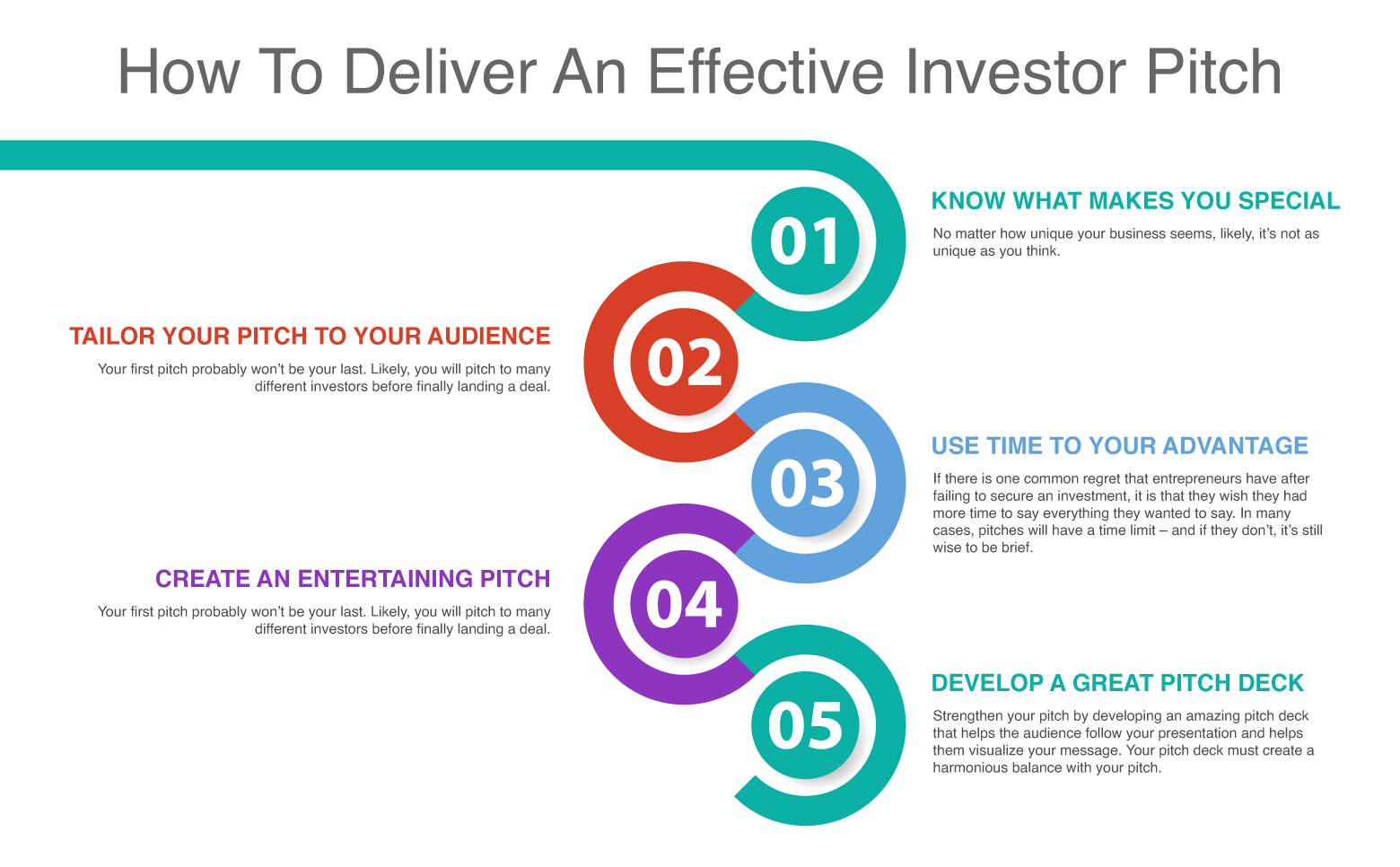You’ve launched your minimal product. You have traction, a business plan, a strong pitch deck, and you’re ready to fundraise… but there’s one issue – you don’t have the first clue on how to pitch to investors. Don’t worry, the pitch process can be frustrating to everyone and it can almost seem scary until you’re actually out there doing it.
If you’ve ever attended a Pitch Day or have witnessed numerous pitches, it’s easy to see that some people seem to have the gift of pitching while others just seem uncomfortable, timid and uncertain. There’s a major difference in these two types of entrepreneurs and it’s not ‘natural talent’ – it’s knowing how to pitch effectively and generating the necessary experience by pitching your business over and over again.
At ThinkLions, we’ve worked with hundreds of businesses around the world – helping them create the best investment tools and consulting with them to develop successful pitches. In this post, we will share a few tried-and-tested tips to help you deliver the best possible pitch and raise the necessary funds for your startup.
What To Do Before You Pitch
There are several things you should do before approaching an investor to maximize your potential for success; but if this is your first time pitching, you should start by familiarizing yourself with the process.
The great thing about living in today’s world is, we have access to things we could never access before the “internet age”. Twenty years ago, you may be walking in to give your first pitch without even knowing what a successful pitch actually looks like. Today, you can simply go on YouTube and type in “pitch competition” or “investor pitch” and watch hundreds of pitches; preparing you for what to expect. Preparation is key, and using tools like YouTube can give you a serious boost and a major advantage when you’re standing in front of a potential investor.
Your first investor pitch shouldn’t the first time you’ve pitched your business. By the time you’re in front of a potential investor, you should have already tested your pitch dozens of times. Write out a few different pitches. Pitch it to yourself in the mirror, pitch it to your family and friends. If you’re tripping over your words and finding that your nerves overtake your delivery in front of your brother or cousin – how do you think you’re going to do when you’re in front of several experienced entrepreneurs and investors? Pitch to anyone that will listen – then ask for their honest feedback. Ask them what parts they understood and what parts they didn’t. Wait a few days and ask them what they remember from your pitch. If they don’t even remember what your business was about – maybe you should go back to the drawing board before pitching in front of an investor.
Finally, record yourself delivering the pitch. Even if you’ve given your pitch in front of family and friends 100 times, there are still weaknesses that you may not notice until you’re actually watching yourself. For example, a client of ours once told us that while he thought his delivery was perfect, he realized only after recording himself that he used the filler “um” over sixty times during his 7-minute pitch. Realizing the existence of this subconscious habit, he started to practice slowing down his delivery and taking small pauses instead of using filler words – a simple solution that made his pitch increasingly more effective.
I know what you’re thinking, “I’m not the type of person that does well speaking in front of people.” Nobody is comfortable speaking in front of strangers, especially not investors, until they have done it over and over. If you’re not good at public speaking, now is the time to build that skill. Raising funds is going to require you to go outside of your comfort zone – shaking unfamiliar hands and pitching crowds that you aren’t used to communicating with.
How To Deliver An Effective Investor Pitch
Putting together a winning pitch isn’t easy. For many entrepreneurs, it’s easy to talk about your business for hours and hours on end, but condensing it to under 10 minutes is a major challenge! To give a great pitch, you’re required to decide which points are most relevant, and then figure out how to tie that information together to persuade investors to be a part of it. Delivering an effective pitch means stepping outside of the box and speaking confidently, even when you know that the odds are against you. Every month, thousands of investors are pitched by new startups – and every month, thousands of startups are rejected. However, out of those thousands of startups, a few will succeed. A select few will break the mold and deliver a pitch that leads to a deal.
If you want to know how to pitch to investors successfully, you’re in the right place. Below, our experts at ThinkLions have put together five tips to help you maximize your chance of pitching yourself into an investment deal.
1) Know What Makes You Special
No matter how unique your business seems, likely, it’s not as unique as you think. You’d be surprised to know how often investors hear, “we are the Uber for (fill in the blank)” or “we have the next solution to disrupt the (fill in the industry) sector”. Ideas are a dime a dozen and you’re not going to turn an investor’s head based upon your idea alone. Find the thing that makes you special – whether it’s the traction you’ve already gained, a new process you’ve perfected, or real lives that your solution has changed. Find your special sauce, and pour it all over your pitch. Investors turn down good startups all the time. Don’t be good, focus on what makes you great.
Take a true assessment of your business. Examine every sentence of your pitch and ask yourself, “has this been said before?” and “has this investor heard this line before?” If the answer is yes, replace it with something that the investor hasn’t heard before. Never leave a gap where an investor has a chance to lose interest – be great from the opening sentence through to the closing.
2) Tailor Your Pitch To Your Audience
Your first pitch probably won’t be your last. Likely, you will pitch to many different investors before finally landing a deal. Investors don’t all have the same goals, objectives, perspectives, experiences or backgrounds. It is critical for you to learn about who you are pitching to before pitching to them. Knowing what is important to them will give you the opportunity to tailor your pitch accordingly.
See what you can find out about the investor or the firm – do they typically invest in startups or existing businesses? What range of funds do they generally offer? Is there a specific industry that they usually invest in? Are there any patterns you realize regarding the businesses they have invested in previously? Ideally, you want your pitch to be like a perfectly wrapped gift for every investor you deliver it to. Your pitch should push the buttons that get them excited and should avoid pressing the buttons that deactivate their enthusiasm. Always remember, an investment deal isn’t a one-way benefit. Don’t just focus on why their investment would be great for your business, but allow them to understand why your business is perfect for their specific investment portfolio.
English novelist Charles Reade once said, “If you wish to please people, you must first start by understanding them.” When it comes to pitching an investor, this couldn’t be truer – if you want them to understand the value of what you are delivering, you must first understand what it is that they find valuable.
3) Use Time To Your Advantage
If there is one common regret that entrepreneurs have after a failed investor pitch, it is that they wish they had more time to say everything they wanted to say. In many cases, pitches will have a time limit – and if they don’t, it’s still wise to be brief. Knowing that you only have a certain number of minutes to deliver all of your information can seem extremely restricting. How do you explain the last year of traction and the next three years of forecasts in ten minutes? In some cases, such as a pitch competition, a team may only have a minute or two to deliver their entire pitch.
Where the average startup sees limitations, a winning team will see an opportunity. A time limit can be used to your advantage if you implement the right strategy. In many cases, investors aren’t really sold until the question and answer portion of the pitch when they get to inquire a bit further. Knowing this, it is wise to strategize your pitch to captivate the audience with strong information; but to present the information in a way that will immediately drive specific questions during the Q&A session.
For example, if I just landed Walmart as a large client, I can set up this information as “we recently secured a partnership with one of the largest retailers on the planet.” By framing the information this way, I know without a doubt that someone will ask, “who is the retailer?” during the Q&A session. Once they ask this question, I can delve into information about the partnership without being held to a time limit. First, know your audience; then use what you know to craft not just the perfect pitch, but the perfect pitch experience.
4) Create an Entertaining Pitch
Just to clarify, this doesn’t mean walking into your pitch dressed as a superhero or doing backflips during your presentation. However, if you’re going to keep someone’s interest for ten minutes, you’ll need to keep them on the edge of their seat.
Consider the way an author or film writer keeps their audience entertained. There’s an introduction where the characters are introduced and the audience is given the chance to relate to the characters. Then, there’s a huge challenge or obstacle that a beloved character is faced with. The climax hits as the character tries to find a solution to their issue. They find a solution and the world is better because of it. Then, there is an ending. In many ways, this is exactly how your pitch should be set up – get them connected to the characters, introduce the problem, build up to the climax, then provide a strong closing.
Investors are pitched by businesses constantly. The majority of pitches they hear, they forget about within an hour. If you want to succeed, your pitch needs to be unforgettable. Whatever method you take to achieve this, make sure that you give a memorable pitch that stays on the investor’s mind even after the pitch has concluded.
5) Develop a Great Pitch Deck
Strengthen your pitch by developing an amazing pitch deck that helps the audience follow your presentation and helps them visualize your message. Your pitch deck must create a harmonious balance with your pitch. It should have enough words to summarize the message, but not so many words that the audience gets caught up in reading the slides instead of listening to your presentation. It should include images and visuals, but not so many graphics that it becomes a distraction to your message. Without using too many words, your pitch deck should be a positive tool that supports your message. Your pitch deck slides should be minimal, but explanatory enough to stand their own and deliver the right message even when you are not pitching.
How To Pitch Investors Successfully
Following these tips will help you put together a pitch that stands out and delivers exactly what investors are looking for. However, if there is one key to success when pitching investors; it is to take each pitch as a learning experience, iterate your delivery, and improve your pitch each and every time. The more often that you stand in front of investors and answer the unexpected questions that may come to you – the stronger, more confident, and more successful you will become in your pitching efforts.
At ThinkLions, we have helped hundreds of startups during the fundraising stages. From business planning and pitch deck consulting to app development and beyond; we are the team you need to help bring your startup ideas to life. Check out one of our sample pitch decks and contact us today!
















